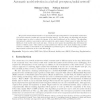Free Online Productivity Tools
i2Speak
i2Symbol
i2OCR
iTex2Img
iWeb2Print
iWeb2Shot
i2Type
iPdf2Split
iPdf2Merge
i2Bopomofo
i2Arabic
i2Style
i2Image
i2PDF
iLatex2Rtf
Sci2ools
MCS
2001
Springer
2001
Springer
Automatic Model Selection in a Hybrid Perceptron/Radial Network
We provide several enhancements to our previously introduced algorithm for a sequential construction of a hybrid network of radial and perceptron hidden units [6]. At each stage, the algorithm sub-divides the input space in order to reduce the entropy of the data conditioned on the clusters. The algorithm determines if a radial or a perceptron unit is required at a given region of input space, by using the local likelihood of the model under each unit type. Given an error target, the algorithm also determines the number of hidden units. This results in a final architecture which is often much smaller than an RBF network or an MLP. A benchmark on six classification problems is given. The most striking performance improvement is achieved on the vowel data set [8].
| Added | 30 Jul 2010 |
| Updated | 30 Jul 2010 |
| Type | Conference |
| Year | 2001 |
| Where | MCS |
| Authors | Shimon Cohen, Nathan Intrator |
Comments (0)

